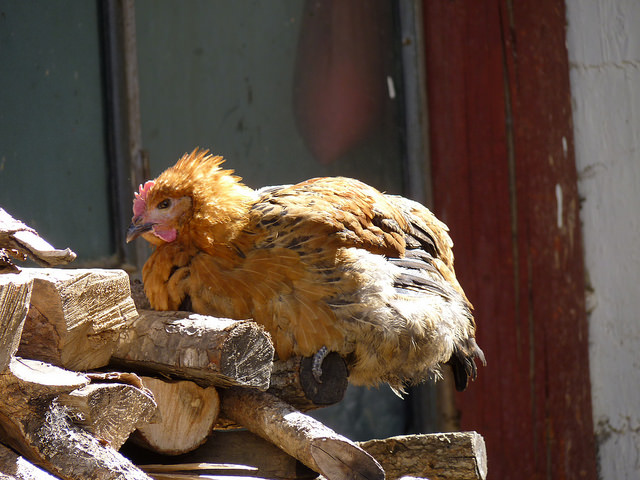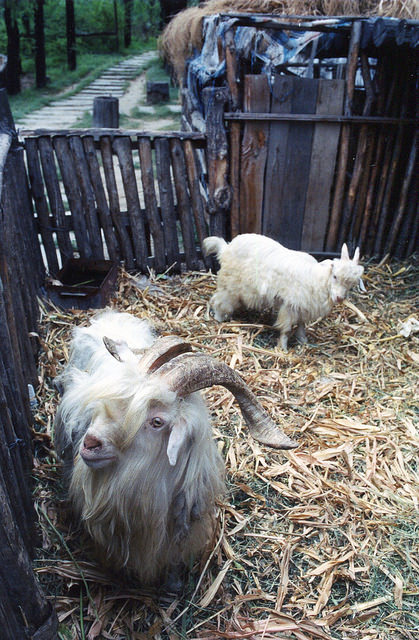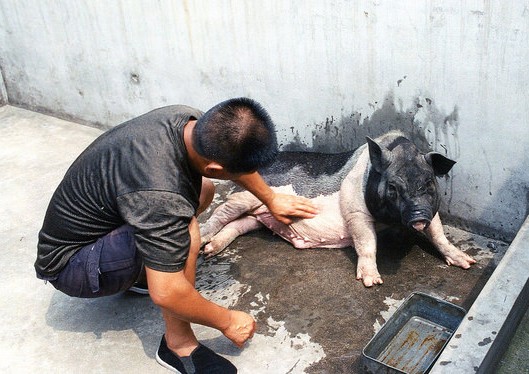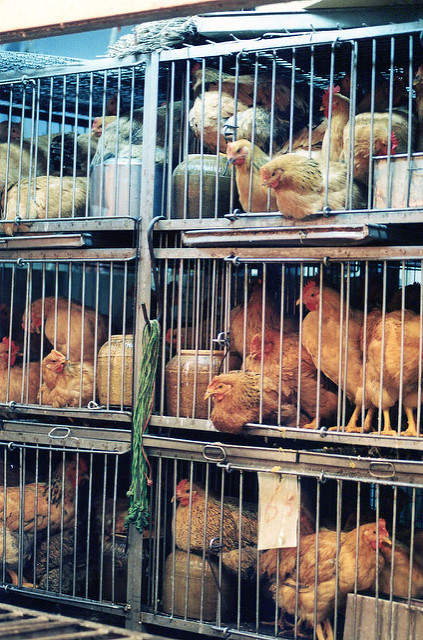(Featured image: food offerings made to ancestors in a Chinese Buddhist temple. Credit Centre for Buddhist Studies (UoB), used under CC BY-NC 2.0)
“A noble person does not depart from Ren for the space of a single meal.” (Confucius, Analects 4:5)
In the teachings of Confucius (551-479 BCE) and his followers, Ren (仁) refers to the ultimate human virtue. It is a homophone of 人, “human” or “person,” from which the written character is partly derived. Combining 人 and 二, the character for “two,” 仁 is considered an innate part of human nature that emerges in relation to others, and can be enhanced and perfected through acts of respect, generosity, and compassion.
On one level, Analects 4:5 simply instructs that Confucians (or Ruists, as some modern practitioners prefer to be called, Ru (儒) meaning “scholar” or “classicist” and long predating the Western name for the religion) never cease to be mindful of virtue. The specific mention of mealtime, however, highlights eating as an act of particular import in choosing whether or not to behave as a respectful, generous, and compassionate person. From Confucius’ time until the present day, one question has loomed especially large over the Chinese dinner table: is it morally acceptable to kill animals for food?
Confucian Virtue and the Consumption of Animals
The virtue of Ren is specifically mentioned by many Ruist scholars as practicable not only toward fellow humans, but toward non-human animals as well. Confucius himself describes the mindset of the ideal person as “earnest and faithful, overflowing in his love for living beings” (Analects 1:6). In the Book of Rites, he honors his deceased dog by commissioning a burial for her, instructing,
“I have heard that a worn-out curtain should not be thrown away, but may be used to bury a horse in; and that a worn-out umbrella should not be thrown away, but may be used to bury a dog in. I am poor and have no umbrella. In putting the dog into the grave, you can use my mat; and do not let its head get buried in the earth. When one of the horses of the ruler’s carriage dies, it is buried in a curtain.” (Book of Rites Book II, Part III, Verse 20)
Japanese Confucian Kaibara Ekken (1630-1714) expands on humans’ moral duty toward animals:
“Heaven and Earth are the heart of living things. Humans receive this heart and it becomes their own. This is Ren. … Nourishing life belongs to Heaven and Ren belongs to humans. … Even birds and animals, grasses and trees, are all made by nature – if we damage them recklessly, we should realize that it is a lack of filiality towards nature.” (cited in Tucker, “The Philosophy of Ch’i as Ecological Cosmology”)
Specifically addressing concern for animals in the context of killing for food, Wang Yangming (1472-1529) says of the noble person that,
“When he sees a child about to fall into a well, he cannot help a feeling of alarm and commiseration. …when he observes the pitiful cries and frightened appearance of birds and animals about to be slaughtered, he cannot help feeling an ‘inability to bear’ their suffering.” (Taylor, “Companionship with the World”)
Wang Yangming echoes Mencius (372-289 BCE), the tradition’s second founding father after Confucius:
“This is the working of Ren… the way of the noble person in regard to animals: if he sees them alive, then he cannot bear to see them die, and if he hears their cries, then he cannot bear to eat their flesh.” (Mencius 1A:7)
It may come as a surprise to readers that, despite sentiments such as those above, mainstream Confucianism has never promoted vegetarianism as a lifestyle. While feelings of compassion for animals are encouraged, and deliberate cruelty condemned, the slaughter of other creatures for food is generally treated as a morally legitimate act.
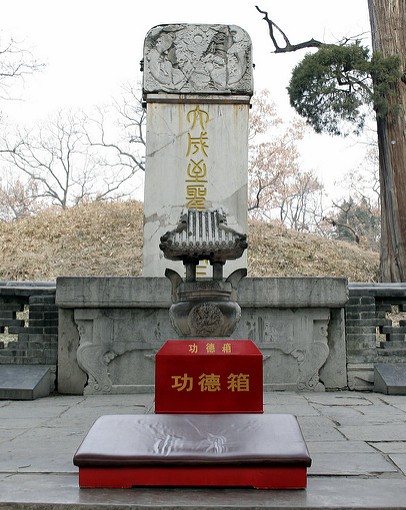
Confucius’ tomb in his hometown of Qufu (photo credit: Preston Rhea, used under CC BY-SA 2.0)
Undoubtedly the most common historical defenses of meat-eating in the West – that it’s necessary for human health, and that animals are inferior beings of lesser moral significance than humans – also played a role in the Ruist judgment. Confucius and his early followers lived hundreds of years prior to the invention of tofu, seitan (wheat gluten), and other vegetarian meats in China, and so were genuinely lacking in nutritional alternatives to animal flesh. Meanwhile, the conception of Ren as a virtue innate to human nature specifically – practicable toward other species, but not by them – reveals an assumption that certain morally relevant abilities are possessed only by Homo sapiens.
However, comprehending perhaps the most important justification for eating meat requires a basic understanding of Confucian history, and the significance of another, closely related use of animals: their ritual slaughter as sacrifices to ancestors and other spiritual beings.
Confucius lived during a time of dangerous political instability. The king of the ruling Zhou Dynasty had become impotent except as a ceremonial figurehead, and actual power was divided between the governors of a number of rival states in tense competition with one another. Shortly after Confucius’ death in the 5th century BCE, this rivalry would erupt into prolonged all-out violence, commencing the era known as the “Warring States period.” Confucius believed such political divisions were the result of cultural decay, and that by restoring the traditions of the past, he could help reverse the process of political decline and return China to a state of harmony and prosperity as known in the early Zhou and previous dynasties. He dedicated his life to studying ancient literature, art, and ritual and transmitting these traditions to his followers, while building political ties with the various rulers in order to maximize his impact on society.
While Confucius’ study of the past preserved an enormous body of valuable knowledge that might otherwise have been lost to history, it also gave his philosophy a backwards-looking, conservative aspect sometimes seemingly at odds with its idealism (by themselves, many of Confucius’ ideas appear progressive even in modern Western context, such as his promotion of universal public education (Analects 15:39) and opposition to wars of expansion (16:1) and tax breaks for the wealthy (11:17)).
Ritual sacrifices, often involving the slaughter of animals, were among the traditions Confucius passed down to his disciples. Surprisingly, he himself appears to have been agnostic as to whether the intended recipients of sacrifice actually existed. According to the Analects, he “did not speak about… anomalies, prodigies, disorder, [or]spirits” (7:20), and told his followers to sacrifice to their ancestors “as if” they were present (3:12). For Confucius, the main importance of ritual lay not in its supernatural effects, but its practical importance to society. Honoring one’s ancestors, even in death, inculcated love for living family members. Venerating local gods and nature spirits encouraged respect for the land and ecosystem. Making offerings to Heaven reminded the emperor that he was entrusted with the good of the world (Tianxia, “All Under Heaven”) and could be overthrown if he abused or neglected his sacred duties to the nation. Finally, the common practice of such related rituals at all levels of society helped maintain a strong sense of national unity and collective duty, empowering the State and its people to stand strong against any obstacle.
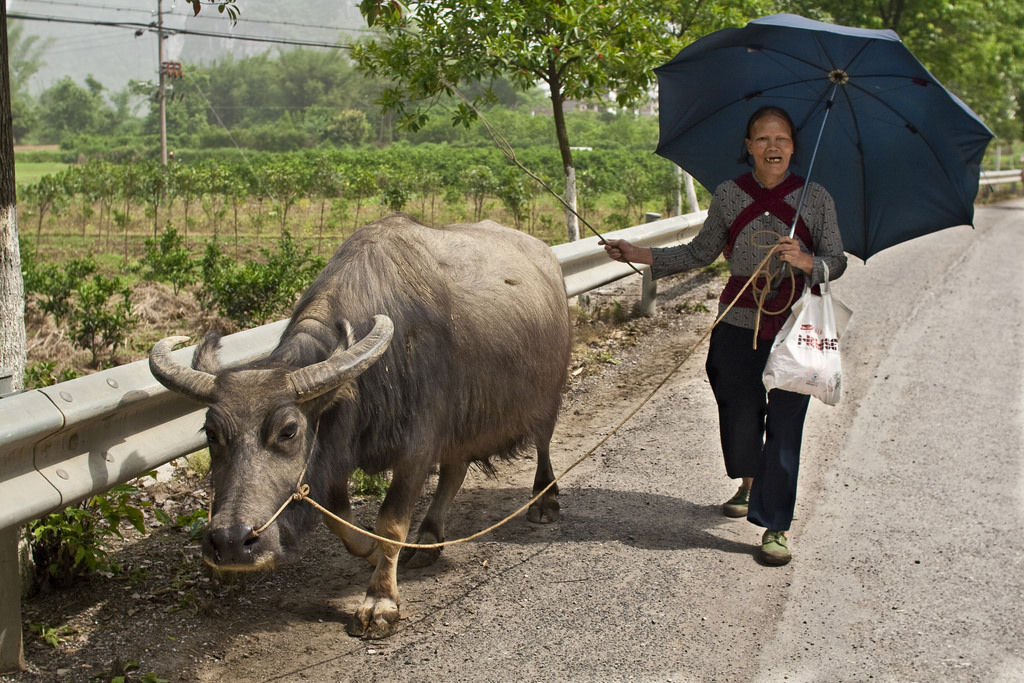
Elderly woman and ox (photo credit: lanchongzi, used under CC BY-NC 2.0)
While often novel in his interpretation of ritual and its symbolism, the explication of which inspired many of Confucius’ most important insights, due to its immense importance to civilization itself he was extremely cautious when it came to making any but the slightest of alterations. Although he broke with tradition in allowing ceremonial caps to be made of black silk, rather than linen as in olden times (Analects 9:3), when a student wanted to do away with killing sheep in a particular ceremony, Confucius refused and told him “You grudge sheep, but I grudge ritual” (3:17).
Most formal animal sacrifices involved distributing the meat among their participants for consumption afterward. In addition, Confucius made a point of offering his own meals as sacrifices before consuming them, especially when they were received as gifts; tradition has it that he even performed a sacrifice with a rotten fish so as to honor the generosity of the poor fisherman who had shared it with him (Kongzi jiayu 2:1b). The relationship between sacrificing animals and eating meat is therefore close and twofold, and goes a long way toward explaining why Confucianism sanctioned both despite encouraging empathy for animals. This can be seen also in the context of Mencius’ assertion, previously quoted, that the noble person “cannot bear” to eat the flesh of an animal he has witnessed killed. Mencius says this to King Xuan of Qi, when the latter tells him how he saw an ox being led to sacrifice and, unable to bear the creature’s frightened trembling, ordered that a sheep be killed instead. Mencius praises the king’s choice of action as a wise compromise between hardening his heart to suffering and dispensing entirely with an important ritual, and says of eating meat in general that “the noble person stays far away from the kitchen” (Mencius 1A:7).
Chinese Buddhism and Vegetarian Controversies
Hundreds of years after Confucius’ lifetime, his tradition’s followers found many of their ideas and practices challenged by a new arrival in China: Buddhism, starting in the 2nd and 1st centuries BCE. Not least among the ensuing controversies was how animals ought to be treated.
Though Buddhism’s founder Siddhartha Gautama, like Confucius, was born into a society that widely practiced animal sacrifice (India, 6th century BCE), unlike his Chinese counterpart the Buddha categorically condemned such rituals as incompatible with ahimsa, the virtue of “harmlessness” also preached by Jain and Hindu reformers. He forbade killing of either humans or animals, instituting as the first of his Five Precepts “to refrain from killing living beings.” In the Jivakka Sutta he describes the negative karma produced by animals’ fear and pain before and during slaughter for food, which accumulates upon butcher, server, and customer alike.
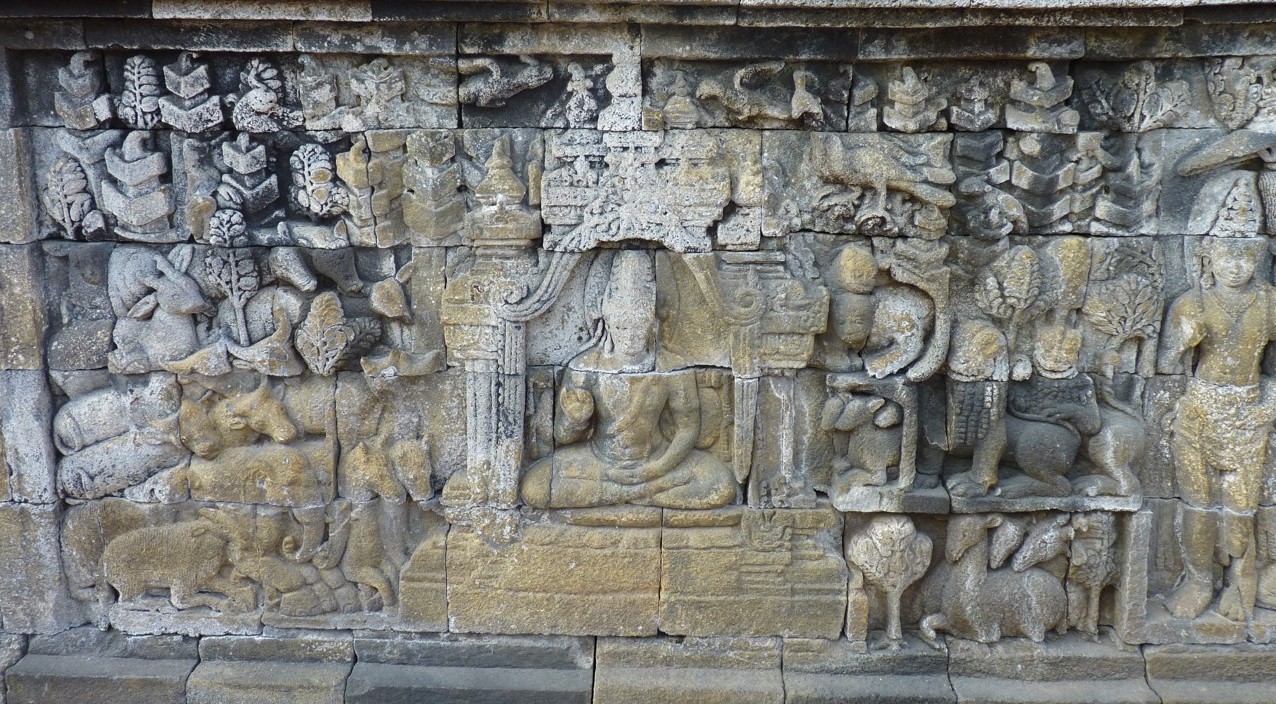
Carving of the Buddha surrounded by animals in Borobudur, a 9th century Buddhist temple in Java, Indonesia (photo credit: Wolf Clifton – Animal People, Inc.)
He did not, however, prohibit the consumption of meat entirely. Monks and nuns, whom he forbade from handling money and so expected to beg for food, were allowed to consume donations of meat provided it was not “seen or heard or suspected” that the animal had been slaughtered specifically for them (Jivakka Sutta). Lay followers were prohibited from working in the meat industry as a livelihood, but not necessarily from eating meat themselves (Vanijja Sutta).
Not long into Buddhism’s spread across China, its Chinese practitioners began to toe a much firmer line when it came to eating meat, with many monks and nuns embracing a fully vegetarian diet. It was lay followers who most actively promoted vegetarianism, however, despite not being held to such as a religious requirement. Popular stories circulated of slaughtered animals’ spirits haunting the people who ate them, and bestowing rewards upon those who refrained. Scholarly officials who had adopted Buddhism penned arguments for vegetarianism which drew heavily from Ruist texts and teachings as well, as in Zhou Yong’s 5th century letter to a friend:
“How can gentlemen of good intentions not embrace reciprocity and bring peace to the border [that divides men from beasts], so that neither harms the other? There is, moreover, no change greater than the change from life to death, no aspect of life more important than life itself. [For the animal] it is its life at stake, and it holds to it dearly; for us it is a flavor, something we can do without.
Yet our entire lives we eat [flesh]at every meal to nourish ourselves, while [animals]harbor resentments they cannot express. My karma stretches back such a long way. Alas, how frightening it is! Yet how easy it is to dote on a tiny, delicate egg in all its frailty; how simple to pity the tender fawn as it takes its cautious steps. Watching animals drink and eat, fly and swim, we feel compassion for them. How can we want to club them to death and eat them so casually? …
Although you do not personally slaughter living creatures, you cannot resist supplying your butcher with geese and carp. A moral man rejects goods that have passed through the hands of bandits. When a life is given over to the knife, how can a compassionate heart bear it? The Zouyu [a fabulous beast mentioned in the Confucian classics] even when hungry will only eat herbs that have died of themselves. On hearing of its virtue, can one help but feel shame?” (cited in Kieschnick, “Buddhist Vegetarianism in China”)
Vegetarianism became the law of the land for Chinese Buddhists under Emperor Wu of Liang (reigned 502-549 CE). Converting to Buddhism during his reign, Emperor Wu made it his mission to propagate a correct understanding of the religion and its values. He organized a conference of monks specifically to debate the question of meat-eating, siding with the pro-vegetarian camp and issuing several edicts requiring monastics to promote vegetarianism. He also forbade animal sacrifice, reforming the Confucian rituals practiced in his court to use only vegetarian elements, and banned hunting and fishing in two regions near his capital.
Why Chinese Buddhists so readily embraced vegetarianism as a preferred lifestyle and monastic requirement has proven vexing for historians to explain. Likely factors include the rise of large monasteries with their own means of food production, and the slow dissemination of Buddhist texts across China, such that general prohibitions on killing such as the First Precept came to be widely known and accepted long before allowances for limited meat-eating as in the Jivakka Sutta.
Another, somewhat counterintuitive possibility is that Confucian values had in fact set the stage for Buddhist vegetarianism in China: specifically, the concept of Ren as a supreme virtue manifest through acts of compassion toward living beings. Indeed, whether by Ruist influence or convergent evolution, compassion in general came to be elevated as a far more important value in Buddhism during its spread across China than it had in the religion previously.
For early Buddhists (and modern followers of the Theravada schools dominant in southeast Asia), the final goal of religious practice was to become an arhat, an enlightened being other than the Buddha, and by attaining nirvana escape the cycle of rebirth once and for all. Over time, some practitioners came to regard this as a fundamentally selfish ambition, focused only on personal karmic purity rather than benefiting others, and seeking liberation from suffering only for oneself. Surely a truly enlightened being – one who had severed all attachments and, letting go of the concept of self, realized their interconnection with all of existence – would desire to end not just their own suffering, but that of all their fellow creatures. Motivated by infinite compassion, they would remain in the cycle of rebirth indefinitely so as to alleviate the misery of others and promote the Buddhist way. Such exalted persons came to be known as bodhisattvas, or “wisdom beings.”
For those Buddhists who embraced the bodhisattva, rather than the arhat, as their spiritual ideal, simply refraining from wrongdoing oneself was not enough. One should seek the active good of others, alleviating suffering however possible. This take on Buddhism came to be known as Mahayana, or the “Greater Vehicle,” denoting its pursuit of infinite compassion as the expansion and perfection of the Buddha’s original, more limited teaching. Within China, it was the Mahayana interpretation that ultimately took root and flourished, along with a myriad of newly revealed scriptures which claimed to record the Buddha’s teachings late in life, or as delivered to spiritual beings in other realms of the cosmos. Many of these categorically forbid meat-eating as incompatible with the bodhisattva path, such as the Mahaparinirvana Sutra, in which the Buddha says, “The eating of meat extinguishes the seed of great compassion.”
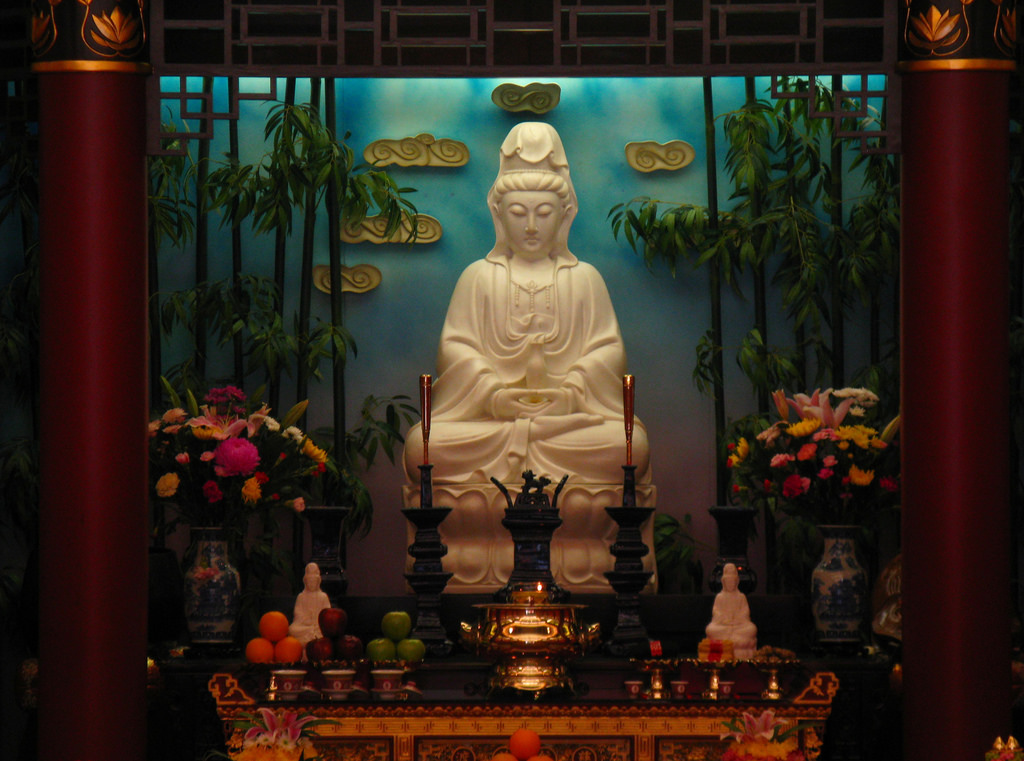
Kuan Yin, the bodhisattva of compassion (photo credit: non-euclidean photography, used under CC BY-NC 2.0)
There are certainly differences between Ren and the bodhisattva ideal. Confucianism portrays the former as a capacity unique to humans, and is generally this-worldly in its moral priorities. Mahayana, on the other hand, rejects human exceptionalism – teaching that all beings share the same buddha-nature and can be reborn across species – and extends the practice of bodhisattva-hood across lifetimes far into eternity. However, Ren and the bodhisattva ideal alike posit compassion as the expression of a supreme, innate virtue, to be perfected through the way one treats others; conceptualized within different worldviews, and manifest in different lifestyles, but sharing a common ethical core.
With this in mind, it is not difficult to believe that Ruism may have had an influence in the flowering of Mahayana and, despite its own sanctioning of animal slaughter, the spread of vegetarian practice within Buddhism. Indeed, as we have seen previously, Zhou Yong in his vegetarian advocacy alludes to Confucian concepts such as reciprocity, being “unable to bear” others’ suffering, and the Zouyu beast of classical literature. Emperor Wu is also known to have cited Mencius for moral precedent in his arguments as to why Buddhists should be vegetarian.
Why, then, did Ruists themselves not come to embrace vegetarianism and abandon animal sacrifice? In certain times and places, of course, they did: As we have seen previously, Emperor Wu forbade the slaughter of animals in his own court’s rituals. During the Tang Dynasty, killing of animals for food was illegal three months and 10 days out of every year, as decreed by Emperor Gaozu in 619 CE and enforced for nearly 300 years. Yet when not commanded otherwise, the Confucian orthodoxy always appears to have sided with slaughter. This was undoubtedly due in part to the influence of leading figures like Zhu Xi (1130-1200), a renowned Ruist scholar known for establishing the tradition’s canon of “Four Books” still used today, and who argued against the practice of vegetarianism:
“The Buddhists and Daoists claim to have insights, but they see nothing more than emptiness and extinction. … There is nothing closer than the relationship between a father and child, yet they abandon father and child; there is nothing more weighty than the relationship between a ruler and his subject, yet they reject ruler and subject. All in life that is moral and indispensable, they dispense with. What is it that they see! The sages said, ‘Be attached to your parents, but benevolent toward the people; be benevolent with the people but sparing with creatures.’ Yet [Buddhists and Daoists] are not attached to their parents, insisting instead that the people ‘spare’ creatures.
[According to Confucian texts] to be ‘sparing’ with creatures means to eat according to the seasons and use with restraint. ‘Once having seen them alive, he cannot bear to see them die, and once having heard their cry, he cannot bear to eat their flesh.’ In mid-spring, one should not use the female beasts in sacrifice, or musk-deer or eggs; one should not kill an embryo or unhatched thing. This is all that is meant.But Buddhists instead do not eat meat or other ‘unclean’ foods. They even go so far as to cast themselves before tigers! What reason is there to all this?” (cited in Kieschnick, “Buddhist Vegetarianism in China”)
Zhu Xi argues here that Buddhist vegetarians have their priorities out of order. Compassion toward animals may be worthwhile, but one’s duties toward other humans and, particularly, one’s family and rulers must always come first. Considering Buddhists to be neglectful toward their families and society, he diagnoses their focus on not harming animals as the reason why. Confucians, Zhu Xi maintains, keep the proper balance of moral concern by killing animals for food and sacrifice, limiting their compassion for non-humans so that they have more to offer their own kind.
(It should be noted that in claiming Buddhists and Daoists “abandon father and child” and “reject ruler and subject,” Zhu Xi misrepresents his opponents. In fact, by the 12th century Buddhists had long embraced the same values of filial piety and reverence for ancestors promoted by Ruists. Chinese Buddhist funeral ceremonies included elaborate procedures to assist departed relatives in their journey through the afterlife, ensuring them a favorable rebirth through vegetarian offerings and dedication of good deeds. The biography of Kuan Yin, the most celebrated bodhisattva in China, portrays her as a shining exemplar of traditionally Confucian values, including filial piety, resistance to tyranny, and leadership through moral example (albeit also a challenge to patriarchal norms in both religions). Born the daughter of a cruel king, Kuan Yin defies her father’s unjust orders yet secretly gives up her own eyes and hands to cure him when he falls ill, and through her ceaseless practice of virtue finally inspires him to reform his ways for the good of the kingdom.)
The venom with which Zhu Xi condemns (and conflates) Buddhism and Daoism belies another major factor in why Confucians continued to defend meat-eating and animal sacrifice: such practices had become symbols of their religious identity. This was particularly so when it came to slaughtering cattle. Starting in the 9th century many Buddhists and Daoists alike began calling for total abstention from cow and buffalo flesh, which they portrayed as particularly sinful meats resulting in automatic damnation to Hell. Likely this taboo on beef began as an easier alternative to vegetarianism, or a stepping stone for people becoming vegetarian, much as many Westerners today give up eating “red meat” while still consuming poultry and seafood. By the 16th century its observance became nearly universal within mainstream Han Chinese society. Besides ethnic minorities, foreigners, soldiers, and criminals, the only major group to continue eating beef after this time (until the end of the Qing Dynasty in the early 20th century) were Ruists. Confucius himself had long been venerated through sacrifices of cattle twice every year, the meat afterward being distributed among his devotees, and many temples continued the practice despite the beef taboo. While some individual Confucians did choose to avoid beef, or even to practice full vegetarianism, others made exceptions when it came time to sacrifice, and some even made a point of sacrificing cattle not just to Confucius, but to other deities and their ancestors as well.
Confucius once described himself as “a transmitter and not a maker, trusting in and loving antiquity” (Analects 7:1), and his followers also saw themselves as stewards of traditional Chinese civilization. Daoism, while equally ancient within China, tended to oppose the traditions and power structures Ruists held dear. Buddhism was regarded as intrinsically foreign due to its Indian origins, even many centuries after it had fully integrated into Chinese culture. Accordingly, even though Confucian philosophy itself values kindness to animals and offers seeming precedents for vegetarianism, once Buddhists began to promote the practice and, over time, many schools of Daoism adopted it as well, Confucians chose to differentiate themselves from their rivals by siding firmly with tradition against innovation.
Moral Crises in Modern China
For modern readers, foreigners and Chinese alike, it may come as a surprise to learn that China has such ancient traditions of compassion for animals and vegetarianism. Today, when Chinese treatment of animals makes international headlines, it’s almost always due to some barbaric spectacle of unimaginable cruelty: Public festivals where stolen pets are killed and eaten. Bears kept immobile in cages and “milked” for their bile. Disposable keychains sold with live turtles, fish, or amphibians trapped inside. Meat animals cooked and fur animals skinned while still fully conscious. Endangered species from around the world driven to the brink of extinction due to Chinese demand for their body parts. The list of atrocities goes on.
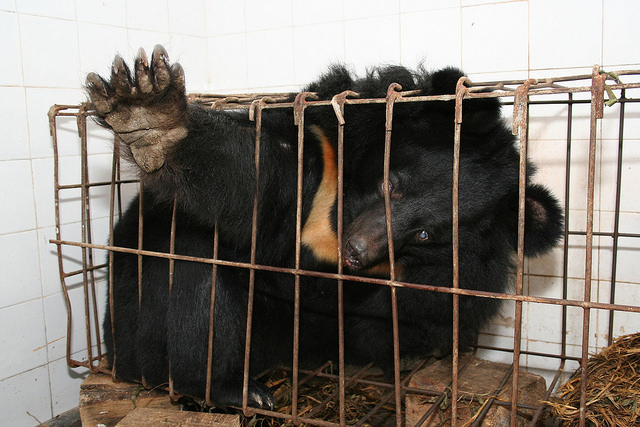
Moon bear caged in bile farm (photo credit: Animals Asia, used under CC BY-NC 2.0)
According to historian Peter Li, the discrepancy between such brutal acts, and the humane teachings of China’s religious traditions can be explained by the violent break in Chinese civilization which occurred during the 20th century. Under the Chinese Communist Party, which took control of China’s government in 1949, and particularly during the Cultural Revolution of 1966-1976, traditional value systems were mercilessly repressed to make way for a new socialist order based in Marxist principles. Buddhist monks were forced at gunpoint to dismantle their own monasteries. Daoist religious sculptures were melted down into scrap metal. Confucius’ family cemetery in Qufu was desecrated, his descendants’ corpses unearthed and hung from trees.
Not only were religious practitioners brutalized, but even their most fundamental shared values were relentlessly attacked. “In a class society there can be only class love,” wrote Chairman Mao Zedong, and under his rule anyone caught expressing sympathy for those designated “class enemies” – former landowners, scholars, aristocrats, political dissidents, and their families – risked facing the same revocation of rights and lifelong discrimination. Meanwhile, zealous youth recruited into the Red Guard were encouraged to put their teachers and even their own parents on trial, testing their commitment to state ideology. By publicly humiliating and abusing those who failed such tests, young Chinese demonstrated that their loyalty to the nation came before respect for elders or any other human relationship.
Mencius once said,
“The trees on Ox Mountain were once beautiful. But being situated on the outskirts of a large state, the trees were hewn down by axes. Could they remain beautiful? … So it is also with human beings… If one lets go of the innate good mind, this is like taking an axe to a tree; being hewn down day after day, can it remain beautiful? … Given nourishment, there is nothing that will not grow; lacking nourishment, there is nothing that will not be destroyed.” (Mencius 6A:8)
And indeed, with respect even for parents and teachers hewn down and the fundamental values of Chinese morality torn up by the roots, it is little wonder that compassion for animals disappeared as well. In 1958, Chairman Mao declared war on sparrows, commanding that all citizens, even young children, personally participate in killing them by any means whatsoever. Their wings and legs were broken, eggs crushed, and nests destroyed, often in contests rewarding whoever could exterminate the most birds. Though Mao insisted that wiping out the sparrows, whom he claimed ate farmers’ grain, would alleviate food shortage, in fact it did exactly the opposite by allowing populations of crop-eating insects to explode unchecked. During the ensuing great famine, in which some 40 million people died of starvation, people turned to desperate measures in order to survive. With government assistance they began scouring the wilderness in search of wild animals to eat, imperiling many species and creating lasting tastes for meats that had never before been popular.
Perhaps the greater mystery, then, is not the widespread cruelty toward animals in China today but the survival of compassionate values at all. Now tolerated under the comparatively moderate policies of the present government, Chinese animal activists have in recent years made great strides in advancing animal protection. Campaigns against fur and dog and cat eating have met with particularly broad public support. ACTAsia’s 2014 and 2015 Cruelty Free Fashion Shows were attended by many Chinese designers and celebrities, and the charity has been formally recognized by the government as one of the top ten most influential organizations in China. In 2011, local authorities shut down the Jinghua Dog Meat Festival following mass protests, and in 2015 one of the oldest dog meat restaurants in Guangzhou went out of business after 51 years. Activists are hopeful that the infamous Yulin Dog Meat and Lychee Festival – which, despite claims of preserving “tradition,” only began in 2010 – may soon follow.

On Tomb Sweeping Day, a traditional Chinese holiday, schoolchildren pay their respects to the graves of bears formerly farmed for bile, at Animals Asia’s bear sanctuary in Chengdu (photo credit: Animals Asia, used under CC BY-NC 2.0)
Traditional Chinese religions have also begun to make a comeback, both within their homeland and abroad. For modern Chinese Buddhists and Confucians, concerns as to how animals ought to be treated are as relevant now as ever. However, the precise questions that must be asked, and the answers practitioners must develop, are different now than they have been in previous centuries. The animal problem, as faced by Ruists and Buddhists in the 21st century, is complicated by the rise of new scientific knowledge of animal intelligence, and emergence of uniquely modern and horrible new forms of animal exploitation.
Animals in the New Light of Science
In 1960, anthropologist Jane Goodall proved that wild chimpanzees could use tools, an ability previously considered unique to human beings. So earth-shattering was this to anthropocentric Western worldviews – which for over 2,000 years had assumed Homo sapiens to be the sole rational creature on Earth – that Goodall’s supervisor, Louis Leakey, remarked “Now we must redefine ‘tool,’ redefine ‘man’ or accept chimpanzees as human.” Thanks to the scientific revolution Jane Goodall began, many non-human animals are now known to use and even design tools, including many primates as well as sea otters, ravens, jays, and even octopuses and certain fish. This shows that they possess a number of advanced underlying cognitive abilities, including reason, creativity, and planning for the future.

Grouper and moray eel hunting together (photo credit: Andy Blackledge, used under CC BY 2.0)
Startling as non-human animals’ capacity for reason may be for Westerners, given their emphasis on interpersonal morality Chinese Buddhists and Confucians will probably take greater interest in other species’ complex social behavior. Chickens, for example, form elaborate hierarchies which determine each bird’s food and mating access. Roosters will call out to hens when they find food, and hens use facial recognition to recall and preferentially mate with the best providers. They also remember and avoid males who call out deceptively to try and trick them into mating.
Primates, sheep, cattle, and dogs can also recognize eachothers’ faces, and many mammals communicate through facial expression. While birds lack the musculature for facial expressions, they can still communicate with their eyes, and some species such as jackdaws can follow eachothers’ gaze. Such “body language” is also documented among fish and invertebrates. Honeybees can convey both the direction and distance of food sources through elaborate “waggle dances.” Groupers hunt cooperatively alongside moray eels and wrasse, and coral trout alongside octopuses, using physical gestures to indicate the direction of prey to their inter-species partners.
Altruism, empathy, and reciprocity play a major role in many animals’ social lives. In laboratory settings, when chimpanzees and rats are presented with a choice either to obtain food for themselves or share it with a partner, both species consistently choose to share. Some studies have greatly raised the stakes, requiring macaques to electrically shock other monkeys in order to obtain food for themselves. Most monkeys choose to starve rather than inflict pain on others, with those that have suffered electric shocks themselves going the longest without food, up to twelve days in one documented case. In nature, vampire bats display an ethic of reciprocity in which successful hunters regurgitate blood to feed those unable to find their own prey. Bats have high metabolisms and can starve to death within a day if they don’t eat enough, making blood-sharing a very risky act, but it pays off when beneficiaries return the favor in times of dire need. Ravens similarly alert other birds to join them whenever they find carrion to eat.
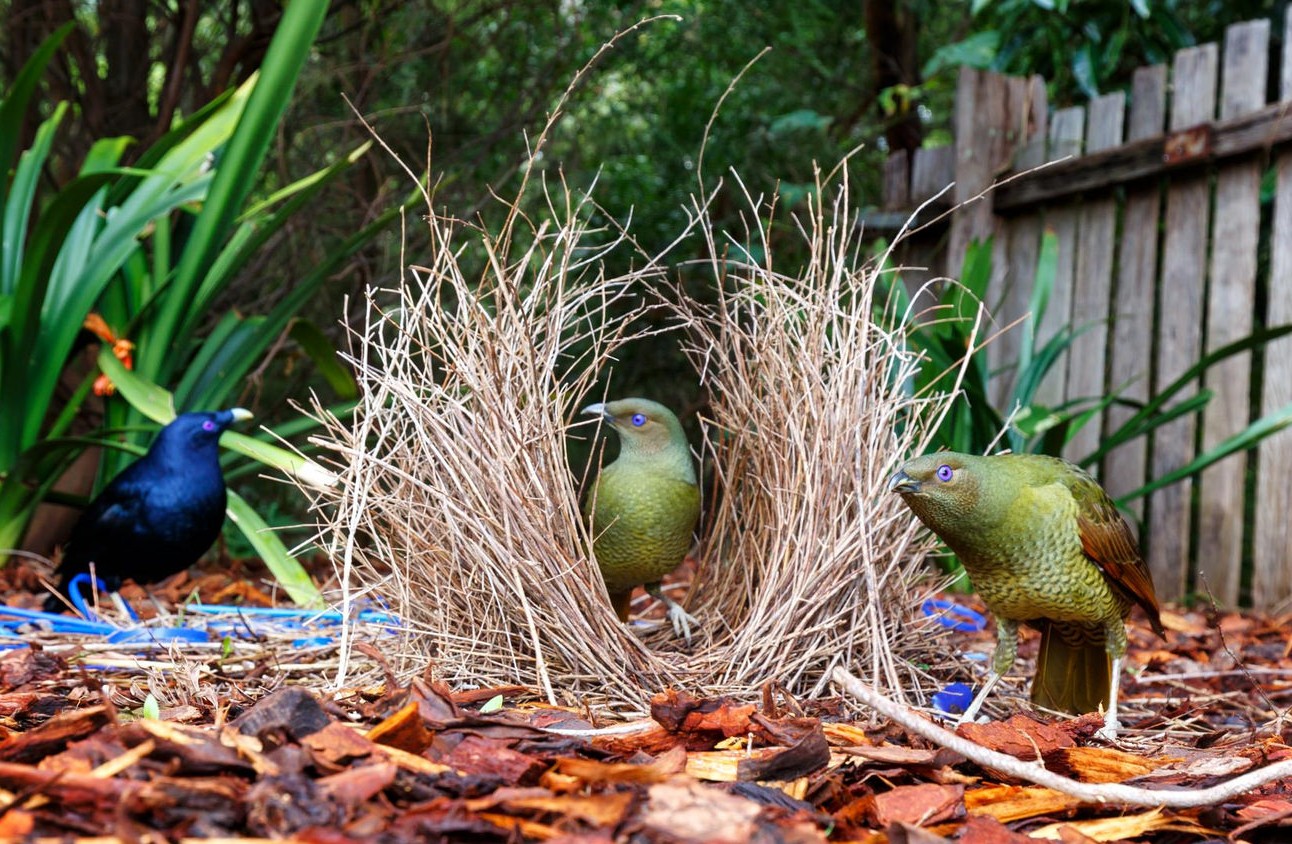
Female bowerbirds inspect a bower, while the male waits outside (photo credit: doug, used under CC BY 2.0)
Perhaps most startling of all are findings indicating culture, language, and even religion among animals. Male Vogelkop bowerbirds, who build and decorate elaborate bowers in order to attract mates, first learn to create bowers by imitating older individuals. However, as they grow more skillful they experiment with different shapes and ornaments, developing their own individual styles. Over time, this has led to the development of distinct bowerbird cultures, varying widely in the designs of their bowers between different geographic regions. Orcas, or killer whales, can be classified into distinct “clans” which overlap in territory, but use different sounds to communicate, feed on different prey animals, and engage in different types of play. Within each orca culture, there are multiple “subcultures,” smaller groups which vary their calls in a manner much like human accents.
Many animals possess analogues to human language, such as different “words” used by monkeys, squirrels, meerkats, and chickens to describe different predators. In laboratory settings, great apes can be taught human sign language; dolphins, artificial languages of electronic noises; and African grey parrots, hundreds of spoken words and basic English grammar. The most complex known in nature, however, is the “language” of prairie dogs, who have been shown to use adjectives, modifying their calls to convey detailed information, such as the size and shape of an object and even the color of a human intruder’s shirt.
Finally, there exists provocative evidence that certain animal species may possess forms of spirituality. Wild chimpanzees have been observed throwing rocks at particular trees or piling them up inside the trunks, a regularly repeated practice that does not clearly serve any practical purpose. Other studies have found that chimps gather several times per year at a waterfall in Tanzania to rhythmically “dance” or sit and gaze at the water, which Jane Goodall herself interprets as signs of spiritual wonder in the video clip below. Similar dancing is also known during rainstorms, and in response to savanna fires, which chimpanzees deliberately approach rather than flee. Chimps also appear to mourn their dead, as do dolphins and, most intently, elephants. Elephants stand watch over the bodies of recently deceased herd members for days on end, sometimes receiving visits from related or unrelated herds come to “pay their respects.” Moreover, once the remains have decomposed they often bury the skeleton, periodically returning to visit the site, or even carry the bones of loved ones with them for years on end, suggesting that elephants, like good Confucians, possess a kind of filial piety that transcends death.
Despite such overwhelming scientific evidence that non-human animals are intelligent, sensitive, and social beings, the magnitude of cruelty with which they are treated has never been greater. With a population of over seven billion and growing, there are many times more humans alive on Earth today than at any time before the 20th century, and as countries have become more economically developed, per capita meat consumption has greatly increased, even in societies that have long been largely vegetarian. Meeting such unprecedented demand for meat requires the slaughter of countless billions of animals. In the U.S. alone, over 10 billion mammals and birds, and 50 billion fish and marine invertebrates, are killed every year. In China the total death toll is at least twice as high. Although on an individual basis, Chinese still only eat about half as much meat as Americans on average, the country’s population of nearly 1.4 billion people makes China the world’s single largest consumer of meat by far.
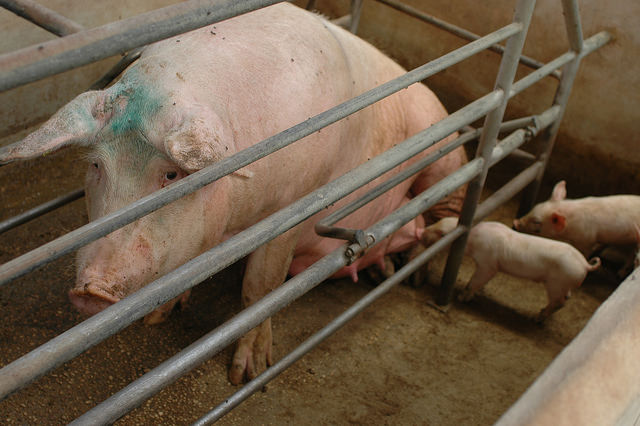
Mother sow nursing piglets in farrowing crate. Sows are kept caged most of their lives to keep them from fighting due to overcrowding. (photo credit: Kim Bartlett – Animal People, Inc.)
The vast majority of animals raised for food spend their lives in intensive factory farms. Factory farms maximize economic efficiency at the expense of animal welfare, often confining animals in extremely small, crowded spaces with little if any access to sunlight, fresh air, or even room to turn. Although unlike meat, eggs and dairy do not intrinsically require the killing of animals, the egg and dairy industries also use factory farming and contribute enormously to animal death and suffering. The average laying chicken in an egg farm has only 67 square inches of cage space (less than a sheet of letter-size paper); and half of all birds are killed immediately after hatching, male chicks being discarded into grinders, electrocuted, or packed into trash bags to suffocate. So-called “free range” farms mitigate some of the worst abuses, but their animals still typically suffer branding, castration without anesthesia, overcrowding, limited outdoor access, and are eventually killed in the same industrial slaughterhouses as their more cruelly raised brethren.
Modern slaughterhouses are often partly mechanized, and operate at extremely rapid paces, resulting in imprecise stunning and killing methods. As a result, a significant number of animals remain conscious as they are defurred or defeathered, skinned, and dismembered. And this is to say nothing of the deliberately sadistic acts seen in footage from undercover investigations. Professor Temple Grandin of Colorado State University, who works as a consultant to the livestock industry in promoting humane slaughter techniques, confirms that these are not isolated incidents. In fact, she writes that sadism is one of the three most common coping mechanisms used by slaughterhouse workers, who emotionally distance themselves from the suffering they inflict by learning to enjoy it (the other two are mechanization, accepting slaughter as a duty to be carried out without emotion; and ritualization, assigning it religious or ideological significance in order to justify it). The psychological toll of slaughter on its human participants is further shown by the prevalence of traumatic stress disorders in slaughterhouse workers, and increased rates of crime and arrests in communities with slaughterhouses.
New Questions for Confucians and Buddhists
Given the unique realities of animal suffering in modern times, and what is now known scientifically of animals’ capacities and the psychology of human-animal relations, Confucianism’s traditional answers to the questions of meat-eating and sacrifice no longer suffice. The questions have themselves changed too much.
The exact nature of the modern animal problem varies some for different Ruist practitioners. 21st century Confucianism can be divided into two main camps: so-called “New Confucians,” and conservatives. New Confucians align themselves with modernity and take a critical, progressive approach to their religious heritage. Besides traditional Ruist ideas and practices, they also study modern political theory, feminism, and Western philosophy, whose critiques they acknowledge and work to address. New Confucians’ goal is to create a new, reformed version of Confucianism, stripped of obsolete elements yet still meaningful in the ethical guidance it provides. A subset of New Confucian scholars, sometimes dubbed “Boston Confucians” due to their concentration in universities in that city, seek to reinvent and promote Ruist teachings not just in Chinese society, but within a Western cultural context as well.
New Confucians have already dispensed with animal sacrifice. While they maintain the importance of ritual to society and self-cultivation, they do not demand the practice of any particular liturgy. “It does not really matter what forms are practiced,” writes Boston Confucian scholar Robert Neville, “so long as they work to give existence to the cultural virtue in question.” Within the Facebook group “Friends From Afar: A Confucianism Group,” started by Bin Song (Boston University) and Ben Butina, many discussions revolve around the creation of new rituals attractive to modern practitioners, and resurrection of traditional Western social rituals (such as rules of etiquette and holiday festivities) as means of cultivating virtue. Accordingly, there is no reason for New Confucians to sacrifice animals so long as the values they promote can be cultivated by other means. Indeed, given the proven dehumanizing effects of slaughtering animals, it is better for the creation of a virtuous society that they do not.
The questions for New Confucians therefore focus entirely on the slaughter of animals for food. Unlike in Mencius’ time, there is no need for the noble person unable to bear animal suffering to “stay far away from the kitchen;” given the abundance of affordable, healthy meatless options in modern times, one may instead frequent vegetarian or vegan kitchens with a clean conscience. For the virtuous New Confucian, is choosing to eat meat anyway not “abandoning Ren for the space of a meal?”
Furthermore, in displaying capacities for culture, morality, and even spirituality, some non-human animals prove themselves capable of the same abilities long exalted by Confucians as granting special moral significance to humans:
“The mind’s feeling of pity and compassion is the beginning of Ren; the mind’s feeling of shame and aversion is the beginning of rightness; the mind’s feeling of modesty and compliance is the beginning of propriety; and the mind’s sense of right and wrong is the beginning of wisdom. Human beings have these four beginnings just as they have four limbs.” (Mencius 2A:6)
If non-human animals possess moral “beginnings” like Homo sapiens, then New Confucians ought to consider them not only through the lens of compassion toward living beings in general, but also the specific ethical principles that guide human interactions. For example, the principle that all relationships are reciprocal, and that a ruler is only entitled to govern so long as he does not neglect or abuse his authority. If he does, the Mandate of Heaven falls from him to his people, granting them the right to overthrow and replace him. Even if humans can rightfully claim rulership over the animal kingdom, is exploiting other species for their meat, eggs, and dairy without being given consent, or providing anything in return, not a dangerous abuse of our power?
For Ruists of the other, more conservative camp, the weight of tradition carries greater authority than ethical precepts by themselves. While conservative Confucians also seek to understand and address specifically modern problems, their goal is not to update Ruism for the 21st century, but to reform modern society in accord with traditional Ruist practice. Accordingly, ancient values and rituals should not be changed simply because they conflict with modern sensibilities. In this spirit, scholar Fan Ruiping of the City University of Hong Kong defends the continued relevance of animal sacrifice. He cites Confucius’ refusal to reform the sheep sacrifice – “You grudge sheep, but I grudge ritual” – and accuses New Confucians who prioritize the lives of animals above tradition of diminishing the proper sense of “reverence for deities and humans.”
For conservative Ruists, the issue of meat-eating still remains closely intertwined with the practice of animal sacrifice, as it did in the time of Confucius and his early followers. So long as ritual slaughter is upheld for antiquity’s sake, pro-vegetarian readings of Mencius or Wang Yangming’s philosophy will carry little force for those in Fan Ruiping’s camp.
Nonetheless, even if traditional practices are not to be changed lightly, conservative Confucians should still at least consider for themselves the magnitude of the modern animal problem. After all, Confucius did instruct that “in matters of Ren, do not defer even to your teacher” (Analects 15:36). Of them it may be asked: even if their tradition’s founder “grudged ritual” above the lives of sheep based on the knowledge and priorities of the late Zhou period, if he were alive today and knew that sheep were intelligent, social and sensitive beings; that they and other animals were raised and slaughtered by the billions in torturous conditions; that humans could live healthily without meat; that the act of slaughter desensitized people and induced sadism; and that Chinese civilization had gone periods of centuries with only vegetarian rituals and survived; would he still expect his followers to make the same choice?
As for Buddhism, while many Mahayana schools of Chinese origin (including those of Korea and Japan, which share historical roots in China) continue to promote vegetarianism, others have discarded the practice as mere antiquated baggage. In the U.S., a number of Buddhist temples have hosted chicken teriyaki dinners as outreach events, and in Tokyo, ordained monks serve both meat and alcohol (forbidden by the Fifth Precept) to paying customers at the Tera Cafe. They justify such deviations from doctrine as necessary to keep Buddhism relevant and attract new practitioners within increasingly secular societies. Yet Buddhists of this inclination could stand to take a lesson from Confucius, and not lightly dismiss traditional practices without first seriously considering their moral import.
In fact, the practice of vegetarianism is more relevant for Buddhists today than at any other time in history. True, the Buddha may not have forbidden eating meat per se, but he did forbid killing for it, or paying others to do so on one’s behalf. In a modern capitalist economy driven by supply and demand, in which every purchase of meat funds the slaughter of future animals, it is not merely “seen or heard or suspected” that one is contributing to animals’ deaths; it is known. And with hundreds of billions of animals being raised in dark, crowded enclosures, physically mutilated, skinned and butchered alive on behalf of consumers every single year, the ethical issues at stake go far beyond merely killing. The standard practices of the meat industry closely resemble the hells described in Buddhist cosmology, realms of unending torment into which famous bodhisattvas like Kuan Yin, Manjusri, and Dizang bravely descend to liberate suffering beings. Far from following their example, Buddhists who purchase meat – let alone sell it to others – directly perpetuate the existence of animals’ hells on Earth.
Can one uphold bodhisattva compassion while also knowingly causing immense, avoidable suffering? For Mahayana Buddhists, the question is merely rhetorical.

Animal sculptures in Confucius’ cemetery in Qufu (photo credit: Jacques Beaulieu, used under CC BY-NC 2.0)
__
Related Articles:
“Nourishing Compassion: On the Meaning of Our New Logo”
“Should Buddhist Temples Serve Meat?”
“His Holiness Chatral Rinpoche on Buddhism and Vegetarianism”
Beyond Human: Animals, Aliens, and Artificial Intelligence
__
Bibliography:
Confucian Virtue and the Consumption of Animals:
- Adler, Joseph A. “Response and Responsibility: Chou Tun-i and Confucian Resources for Environmental Ethics.” Confucianism and Ecology: The Interrelation of Heaven, Earth, and Humans. Ed. Mary Evelyn Tucker and John Berthrong. Cambridge, MA: Harvard University Press, 1998. 123-150.
- Bai, Tongdong. “The Price of Serving Meat – On Confucius’s and Mencius’s Views of Human and Animal Rights.” Asian Philosophy 19, no. 1 (March 2009), 85-99.
- Bloom, Irene. “Confucius and the Analects.” Sources of Chinese Tradition, Volume One. Ed. Wm. Theodore de Bary and Irene Bloom. New York: Columbia University Press, 1999. 41-63.
- Bloom, Irene. “Mencius.” Sources of Chinese Tradition, Volume One. Ed. Wm. Theodore de Bary and Irene Bloom. New York: Columbia University Press, 1999. 114-158.
- Hinton, David (Translator). Mencius. Berkeley, CA: Counterpoint, 1998.
- Jiang, Xinyan. “Why Was Mengzi Not a Vegetarianist?” Journal of Chinese Philosophy 32, no.1 (March 2005), 59-73.
- Legge, James (Translator). “The Li Ki (The Book of Rites) Part I.” Internet Sacred Text Archive. 1885 (original publication). http://www.sacred-texts.com/cfu/liki/index.htm
- Puett, Michael. “The Offering of Food and the Creation of Order: The Practice of Sacrifice in Early China.” Of Tripod and Palate: Food, Politics, and Religion in Traditional China. Ed. Roel Sterckx. New York: Palgrave Macmillan, 2005. 75-95.
- Song, Bin. “A Catechism of Confucianism: Is Confucius a Confucian?” Huffington Post. February 9th, 2016. http://www.huffingtonpost.com/bin-song/a-catechism-of-confuciani_6_b_9178068.html
- Sterckx, Roel. “Food and Philosophy in Early China.” Of Tripod and Palate: Food, Politics, and Religion in Traditional China. Ed. Roel Sterckx. New York: Palgrave Macmillan, 2005. 34-61.
- Taylor, Rodney L. “Companionship with the World: Roots and Branches of a Confucian Ecology.” Confucianism and Ecology: The Interrelation of Heaven, Earth, and Humans. Ed. Mary Evelyn Tucker, Mary Evelyn and John Berthrong. Cambridge, MA: Harvard University Press, 1998. 37-58.
- Tucker, Mary Evelyn. “The Philosophy of Ch’i as an Ecological Cosmology.” Confucianism and Ecology: The Interrelation of Heaven, Earth, and Humans. Ed. Mary Evelyn Tucker, Mary Evelyn and John Berthrong. Cambridge, MA: Harvard University Press, 1998. 187-210.
- Watson, Burton (Translator). The Analects of Confucius. New York: Columbia University Press, 2007.
Chinese Buddhism and Vegetarian Controversies:
- Balsys, Bodo. Ahimsa: Buddhism and the Vegetarian Ideal. New Delhi, India: Munshiram Manoharlal, 2004.
- Cabezon, Jose Ignacio. Buddhism, Sexuality, and Gender. United States: State University of New York Press, 1992.
- Goossaert, Vincent. “The Beef Taboo and the Sacrificial Structure of Late Imperial Chinese Society.” Of Tripod and Palate: Food, Politics, and Religion in Traditional China. Ed. Roel Sterckx. New York: Palgrave Macmillan, 2005. 237-248.
- Idema, Wilt L. (Translator). Personal Salvation and Filial Piety: Two Precious Scroll Narratives of Guanyin and Her Acolytes. Honolulu: Kuroda Institute, 2008.
- “Jivakka Sutta.” What the Buddha Said in Plain English. https://what-buddha-said.net/Canon/Sutta/MN/MN55.htm
- Kieschnick, John. “Buddhist Vegetarianism in China.” Of Tripod and Palate: Food, Politics, and Religion in Traditional China. Ed. Roel Sterckx. New York: Palgrave Macmillan, 2005. 186-212.
- Li, Peter J. In the Name of Development: Animals in China (tentative). Sydney, Australia: University of Sydney Press, 2016 (advance draft).
- Palmer, Martin and Elizabeth Breuilly (Translators). The Book of Chuang Tzu. London: Arkana, 1996.
- Robinson, Richard H., Willard L. Johnson, and Thanissaro Bhikku. Buddhist Religions: A Historical Introduction. Boston: Wadsworth, 2005
- Teiser, Stephen F. and Jacqueline Stone. Readings of the Lotus Sutra. United States: Columbia University Press, 2009.
- Teiser, Stephen F. The Scripture on the Ten Kings and the Making of Purgatory in Medieval Chinese Buddhism. Honolulu: University of Hawai’i Press, 1994.
- “Vanijja Sutta: Business (Wrong Livelihood).” Access to Insight. http://www.accesstoinsight.org/tipitaka/an/an05/an05.177.than.html
- Watson, Burton (Translator). The Analects of Confucius. New York: Columbia University Press, 2007.
Moral Crises in Modern China:
- “End Bear Bile Farming.” Animals Asia. http://aldf.org/wp-content/uploads/2013/09/End-Bear-Bile-Farming.pdf
- Hinton, David (Translator). Mencius. Berkeley, CA: Counterpoint, 1998.
- Li, Peter J. “Friend or Food? Dog Meat Trade Divides China.” CNN. June 19th, 2015. http://www.cnn.com/2015/06/18/opinions/china-yulin-dog-festival-peter-li/
- Li, Peter J. In the Name of Development: Animals in China (tentative). Sydney, Australia: University of Sydney Press, 2016 (advance draft).
- Li, Peter J. “Inside Yulin Dog Meat Festival: The Silence of Dogs Awaiting Slaughter is Thundering.” Animal People Forum. April 14th, 2016. https://animalpeopleforum.org/2016/04/14/inside-yulin-dog-meat-festival-the-silence-of-dogs-awaiting-slaughter-is-thundering/
- Li, Peter J. “Seeing Animals as a Resource is a Cruel Substitute for Real Wildlife Protection in China.” Animal People Forum. January 31st, 2016. https://animalpeopleforum.org/2016/01/31/seeing-animals-as-a-resource-is-a-cruel-substitute-for-real-wildlife-protection-in-china/
- “Live Animals Sold as Key Rings in China.” CNN. April 15th, 2011. http://www.cnn.com/2011/WORLD/asiapcf/04/14/china.animal.keyring/
- Neale, Dave. “A Calf is Cooked Alive in China – The Video We Refuse to Share.” Animals Asia. April 15th, 2016. https://www.animalsasia.org/us/media/news/news-archive/a-calf-is-cooked-alive-in-china-the-video-we-refuse-to-share.html
- Pei, Feng-Su. “2015 – What ACTAsia Achieved With Your Help.” Animal People Forum. February 7th, 2016. https://animalpeopleforum.org/2016/02/07/2015-what-actasia-achieved-with-your-help/
- Richter, Darmon. “Cemetery of the Greatest Sage: Searching for the Tomb of Confucius.” The Bohemian Blog. January 2014. http://www.thebohemianblog.com/2014/01/dark-tourism-tomb-of-confucius-china.html
- Schmetzer, Uli. “Making a Comeback in China, Taoism’s ‘Survival is Almost a Miracle.'” Chicago Tribune. April 19th, 1996. http://articles.chicagotribune.com/1996-04-19/news/9604190191_1_wudang-mountain-taoist-nun-taoism
Animals in the New Light of Science:
- Blackmore, Willy. “China Continues to Eat More and More Meat – and That Matters for Everyone.” Take Part. October 13th, 2015. http://www.takepart.com/article/2015/10/13/china-meat-consumption
- “Cage-Free vs. Battery-Cage Eggs.” Humane Society of the United States. http://www.humanesociety.org/issues/confinement_farm/facts/cage-free_vs_battery-cage.html
- Chittka, Lars. “Dances as Windows Into Insect Perception.” PLOS Biology 2, no. 7 (July 2004), http://journals.plos.org/plosbiology/article?id=10.1371/journal.pbio.0020216
- Clifton, Merritt. “World’s Largest Mayonnaise Maker to Seek End to Culling Male Chicks.” Animals 24-7. September 3, 2014. http://www.animals24-7.org/2014/09/03/worlds-largest-mayonnaise-maker-to-seek-end-to-culling-male-chicks/
- Dawkins, Marian Stamp. “Distance and Social Recognition in Hens: Implications For the Use of Photographs As Social Stimuli.” Behaviour 133, no. 9/10 (August 1996), 663-680.
- Diamond, Jared. “Animal Art: Variation in Bower Decorating Style Among Male Bowerbirds Amblyornis inornatus.” Proceedings of the National Academy of Sciences of the United States of America 83 (May 1986), 3042-3046.
- Dillard, Jennifer. “A Slaughterhouse Nightmare: Psychological Harm Suffered By Slaughterhouse Employees and the Possibility of Redress Through Legal Reform.” Georgetown Journal on Poverty Law & Policy 15, no. 2 (Summer 2008), 391-408.
- Edwards, Lin. “Chimps Dance in the Face of Fire.” Phys.org. January 19th, 2010. http://phys.org/news/2010-01-chimps.html
- Fitzgerald, Amy J. “Slaughterhouses and Increased Crime Rates: An Empirical Analysis of the Spillover From ‘The Jungle’ Into the Surrounding Community.” Organization and Environment 22 (2009), 158-184.
- Foer, Jonathan Safran. Eating Animals. New York, NY: Hachette Book Group, 2009.
- Giurfa, Martin. “The Amazing Mini-Brain: Lessons From a Honey Bee.” Bee World 84, no. 1 (2003), 5-18.
- Goldman, Jason G. “Fish Learn To Use Tools, So Let’s Rethink the Definition of Tool Use.” iO9. April 30, 2014. http://animals.io9.com/fish-learn-to-use-tools-so-lets-rethink-the-definition-1569666569
- Goodall, Jane. Through a Window: My Thirty Years With the Chimpanzees of Gombe. Boston, MA: Soko Publications Limited, 1990.
- Grandin, Temple. “Commentary: Behavior of Slaughter Plant and Auction Employees Toward the Animals.” Anthrozoos (1998), 205-213.
- Griffin, Donald R. Animal Minds: Beyond Cognition to Consciousness. Chicago, IL: The University of Chicago Press, 2001.
- Hart, Stephen. The Animal Communication Project. 2012. http://acp.eugraph.com/
- Hoffman, Beth. “How Increased Meat Consumption in China Changes Landscapes Across the Globe.” Forbes. March 26th, 2014. http://www.forbes.com/sites/bethhoffman/2014/03/26/how-increased-meat-consumption-in-china-changes-landscapes-across-the-globe/#d0843c624431
- Honeyborne, James. “Elephants Really Do Grieve Like Us: They Shed Tears and Even Try to ‘Bury’ Their Dead – A Leading Wildlife Filmmaker Reveals How the Animals Are Like Us.” Daily Mail. January 30th, 2013. http://www.dailymail.co.uk/news/article-2270977/Elephants-really-grieve-like-They-shed-tears-try-bury-dead–leading-wildlife-film-maker-reveals-animals-like-us.html
- Jiang, Suwei and Richard Ferguson. China’s Agricultural Challenges: Roads to Be Traveled. London: Pricewaterhouse Coopers LLP, October 2015. http://pwc.blogs.com/files/chinas-agricultural-challenges-6-oct_final.pdf
- Kaplan, Matt. “‘Bizarre’ Octopuses Carry Coconuts As Instant Shelters.” National Geographic. December 15, 2009. http://news.nationalgeographic.com/news/2009/12/091214-octopus-carries-coconuts-coconut-carrying/
- Kehoe, Laura. “The Images of Chimps Thrilled Me: Do They Show Evidence of Spirituality in the Wild?” The Guardian. March 5th, 2016. https://www.theguardian.com/science/2016/mar/06/chimps-more-human-than-we-think?CMP=share_btn_fb
- Keim, Brandon. “Chimps and the Zen of Falling Water.” Nautilus. June 29th, 2015. http://nautil.us/blog/chimps-and-the-zen-of-falling-water
- Kendrick, Keith M.; Ana P. da Costa; Andrea E. Leigh; Michael R. Hinton; and Jon W. Peirce. “Sheep Don’t Forget a Face.” Nature 414 (November 2001), 165-166.
- Al-Khatib, Talal. “Animal Altruism: Lending a Helping Paw (or Wing or Fin).” Discovery News. June 4th, 2015. http://news.discovery.com/animals/animal-altruism-lending-a-helping-paw-or-wing-or-fin-photos-150604.htm
- Krulwich, Robert. “New Language Discovered: Prairiedogese.” NPR. January 20, 2011. http://www.npr.org/2011/01/20/132650631/new-language-discovered-prairiedogese
- Leopold, David A. and Gillian Rhodes. “A Comparative View of Face Perception.” Journal of Comparative Psychology 124, no. 3 (August 2010), 233-251.
- Linden, Eugene. The Octopus and the Orangutan: More True Tales of Animal Intrigue, Intelligence, and Ingenuity. New York, NY: Penguin Group, 2002.
- Main, Douglas. “Fish Use ‘Sign Language’ to Help Hunting Buddies.” Discovery News. April 29th, 2013. http://news.discovery.com/animals/fish-use-sign-language-130429.htm
- Masserman, Jules H., Stanley Wechkin, and William Terris. “‘Altruistic’ Behavior in Rhesus Monkeys.” The American Journal of Psychiatry 121 (December 1964), 584-585.
- Narby, Jeremy. Intelligence in Nature. New York, NY: Penguin Group, 2006.
- “Pigs.” Food Empowerment Project. http://www.foodispower.org/pigs/
- Pruetz, J.D. and T.C. LaDuke. “Brief Communication: Reaction to Fire by Savanna Chimpanzees (Pan troglodytes verus) at Fongoli, Senegal: Conceptualization of ‘Fire Behavior’ and the Case for a Chimpanzee Model.” American Journal of Physical Anthropology 141, no. 4 (April 2010), 646-650.
- “Report: Number of Animals Killed in USA Increases in 2010.” Farm Animal Rights Movement. 2011. http://farmusa.org/statistics11.html
- Slobodchikoff, Con. “About Con’s Work.” Con Slobodchikoff. http://conslobodchikoff.com/
- Slobodchikoff, Con. “Size and Shape Information Serve as Labels in the Alarm Calls of Gunnison’s Prairie Dogs Cynomys gunnisoni.” Current Zoology 58, no. 5 (October 2012), 741-748.
- Srikameswaran, Anita. “Self-Interest Drives Ravens’ Generosity.” Chicago Tribune. August 13th, 1995. http://articles.chicagotribune.com/1995-08-13/news/9508130324_1_ravens-birds-bernd-heinrich
- Stiffler, Lisa. “Understanding Orca Culture.” Smithsonian Magazine. August 2011. http://www.smithsonianmag.com/science-nature/understanding-orca-culture-12494696/?no-ist
- “Video Shows First Tool Use By a Fish.” ScienceBlog. September 28, 2011. http://scienceblog.com/48078/video-show-tool-use-by-a-fish/#vTm4mcaL2syWAIo1.97
- Warrick, Joby. “They Die Piece By Piece: Investigation Reveals Rampant Cruelty in Industrial Slaughterhouses.” Washington Post. April 10, 2001. http://animalrightskorea.org/essays/they-die-piece-by-piece.html
- Wilkinson, Gerald S. “Reciprocal Food Sharing in the Vampire Bat.” Nature 308 (March 1984), 181-184.
New Questions for Confucians and Buddhists:
- Bai, Tongdong. “The Price of Serving Meat – On Confucius’s and Mencius’s Views of Human and Animal Rights.” Asian Philosophy 19, no. 1 (March 2009), 85-99.
- Bell, Daniel A. and Chaibong Hahm. “Introduction: The Contemporary Relevance of Confucianism.” Confucianism for the Modern World. Ed. Daniel A. Bell and Hahm Chaibong. Cambridge, UK: Cambridge University Press, 2003. 1-30.
- Berthrong, John. Transformations of the Confucian Way. Boulder, CO: Westview Press, 1998.
- Bloom, Irene. “Mencius.” Sources of Chinese Tradition, Volume One. Ed. Wm. Theodore de Bary and Irene Bloom. New York: Columbia University Press, 1999. 114-158.
- Butina, Ben. “Tomb Sweeping Day.” Stone Chimes. http://stonechimes.com/tomb-sweeping-day/
- Clifton, Wolf Gordon. “Should Buddhist Temples Serve Meat?” Animal People Forum. September 9th, 2015. https://animalpeopleforum.org/2015/09/09/should-buddhist-temples-serve-meat/
- Fan, Ruiping. “How Should We Treat Animals? A Confucian Reflection.” Dao: A Journal of Comparative Philosophy 9, no. 1 (March 2010), 79-96.
- Fan, Ruiping. Reconstructionist Confucianism: Rethinking Morality After the West. New York: Springer, 2010.
- Hinton, David (Translator). Mencius. Berkeley, CA: Counterpoint, 1998.
- Jiang, Xinyan. “Why Was Mengzi Not a Vegetarianist?” Journal of Chinese Philosophy 32, no.1 (March 2005), 59-73.
- Neville, Robert. “The Short Happy Life of Boston Confucianism.” Confucianism in Context. Ed. Wonsuk Chang and Leah Kalmanson. Albany: State University of New York Press, 2010. 145-174.
- Wang, Yiyuan. “Why a Tokyo Cafe Run By Monks is Putting Buddhism On the Menu.” Huffington Post. April 8th, 2016. http://www.huffingtonpost.com/entry/tera-cafe-tokyo-buddhism_us_5707ef40e4b063f854df87ef
- Watson, Burton (Translator). The Analects of Confucius. New York: Columbia University Press, 2007.


